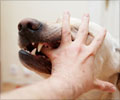Dogs can tell the difference between happy and angry human faces, reveals a new study. This is the first solid evidence that an animal other than humans can identify emotional expressions.

In the study, the researchers trained dogs to discriminate between images of the same person making either a happy or an angry face. In every case, the dogs were shown only the upper or the lower half of the face. After training on 15 picture pairs, the dogs' discriminatory abilities were tested in four types of trials, including
- The same half of the faces as in the training but of novel faces
- The other half of the faces used in training
- The other half of novel faces
- The left half of the faces used in training.
Senior author Ludwig Huber said that the study demonstrates that dogs can distinguish angry and happy expressions in humans, they can tell that these two expressions have different meanings, and they can do this not only for people they know well, but even for faces they have never seen before.
What exactly those different meanings are for the dogs are hard to say, he adds, but it appears likely to them that the dogs associate a smiling face with a positive meaning and an angry facial expression with a negative meaning.
Muller and Huber report that the dogs were slower to learn to associate an angry face with a reward, suggesting that they already had an idea based on prior experience that it's best to stay away from people when they look angry.
The study is published in the Cell Press journal Current Biology.
Advertisement











